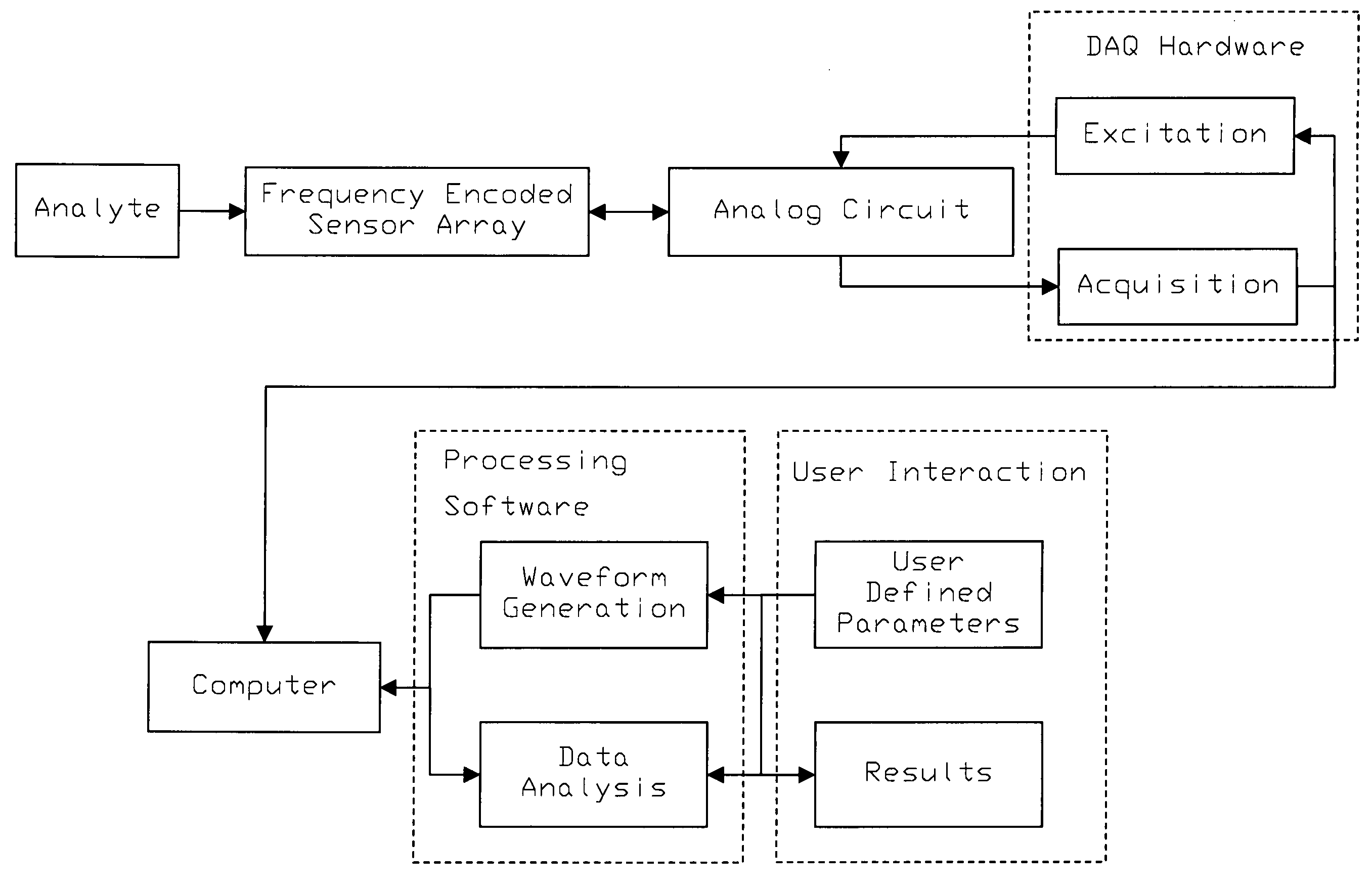Frequency encoding of resonant mass sensors
a technology of resonant mass and frequency encoding, which is applied in the direction of vibration measurement in solids, instruments, and fluid analysis using sonic/ultrasonic/infrasonic waves, etc. it can solve the problems of prohibitive hardware cost, slow detection of the array, and all the technical challenges of cross-reactive sensor arrays described previously, etc., to achieve high q-value, high stability, and sufficient ring time
- Summary
- Abstract
- Description
- Claims
- Application Information
AI Technical Summary
Benefits of technology
Problems solved by technology
Method used
Image
Examples
example 1
Fabrication of a Two-element Frequency Encoded Tuning Fork Sensor Array
Resonant frequencies of two commercial tuning forks were measured in air without coatings by the method described below. One device was coated with paraffing wax by dipping a tuning fork in a 5% wax solution in acetone, without frequency trimming. The tines of the other device were shortened by grinding on a diamond cutting wheel to increase the resonant frequency. After its resonant frequency was measured, the device was coated with PDMS by dipping into an approximately 5% PDMS solution in toluene. The PDMS solution was prepared by mixing 10:1 silicone elastomer base:curing agent in weight, and then adding 95% weight of toluene. The sensors were allowed to dry in air overnight.
The two sensors were connected in parallel and a 4.7 kΩ resistor was then connected in series before connection to a data acquisition card (NI6062, National Instrument, Austin, Tex.), interfaced to a laptop computer through a PCMCIA sl...
example 2
Vapor Component Detection Using a Two-element Tuning Fork Sensor Array
The vapor sensing was conducted using the sensor and data acquisition protocol described in Example 1, at 70° F. (21.1° C.). At this temperature, literature reported equilibrium vapor pressures for the solvents are: 2-propanol at 33.5 torr, toluene at 22.3 torr, and acetone at 170.1 torr. A small amount of one solvent was added to a 20 mL vial, sufficient to saturate the vapor, and the vial was allowed to equilibrate for 10 minutes. The sensor was brought into contact with the vapor in the vial and sensor data was acquired. The analyte-dependent response of the sensor was sufficiently fast and there was no observable change in resonance peak positions for the sensor elements in subsequent acquisitions after the initial measurement of the vapor environment. When the sensor was removed from the vapor, the sensor element frequencies returned to the initial values within 2-3 seconds. In this way, the response of the...
example 3
Fabrication and Vapor Sensing of a 9-element Tuning Fork Sensor Array
Using commercially available quartz tuning fork devices, as described in Example 1, a 9-element sensor array was prepared. Polymers used to fabricate the 9-sensor array were dissolved in THF at a concentration of 2-2.5%, and the forks were dip-coated in these solutions. Pulsed excitation followed by acquisition of the FOD signal was carried out as in Example 1. Peak locations for each sensor element in the 9-sensor array were calculated by a centroid procedure.
As shown in FIG. 9A, the frequency encoded 9-device array before polymer coating occupies a frequency range of 3 kHz (32.5-35.5 kHz). The uncoated sensors are roughly evenly distributed in the frequency range and have a similar q-value (peak width). Sensor #9 (numbered sequentially from low to high frequency) has low signal intensity, and possibly was damaged by the frequency shifting process. Polymer coating also causes a decrease in the q-values for man...
PUM
| Property | Measurement | Unit |
|---|---|---|
| frequency | aaaaa | aaaaa |
| resonant frequencies | aaaaa | aaaaa |
| thickness | aaaaa | aaaaa |
Abstract
Description
Claims
Application Information
 Login to View More
Login to View More - R&D
- Intellectual Property
- Life Sciences
- Materials
- Tech Scout
- Unparalleled Data Quality
- Higher Quality Content
- 60% Fewer Hallucinations
Browse by: Latest US Patents, China's latest patents, Technical Efficacy Thesaurus, Application Domain, Technology Topic, Popular Technical Reports.
© 2025 PatSnap. All rights reserved.Legal|Privacy policy|Modern Slavery Act Transparency Statement|Sitemap|About US| Contact US: help@patsnap.com



